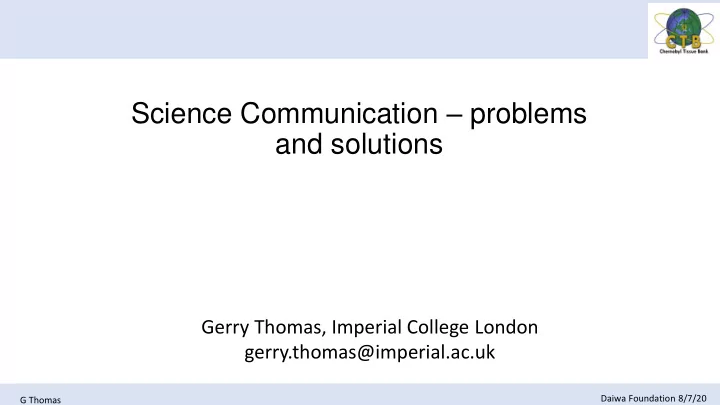

Science Communication – problems and solutions Gerry Thomas, Imperial College London gerry.thomas@imperial.ac.uk Daiwa Foundation 8/7/20 G Thomas
The problem with science communication Gy • Too much jargon mSv • PBq Level of understanding an unconscious biases of audience • Communication of uncertainty Daiwa Foundation 8/7/20 G Thomas
Public lic Perception of Ris isk – Fear Factors • Uncontrollable • Having catastrophic potential • Having fatal or dread consequences • Bearing an inequitable distribution of risks and benefits • Not understood • Novel • Delayed in their manifestation of harm Slovic P. 1987. Perception of risk. Science 236:280 – 85 Daiwa Foundation 8/7/20 G Thomas
Communication of risk and uncertainty – with whom x 2 x 1 Daiwa Foundation 8/7/20 G Thomas
Communication of risk and uncertainty – by whom Daiwa Foundation 8/7/20 G Thomas
Rings represent 2 and 3 km from epicenter Red >1000mGy 5% Orange 500-1000mGy Yellow 200-500mGy Green 100-200 mGy Brown 5-100 mGy 84% Pink <5 mGy McClean et al., Proc. R. Soc. B (2017) 1070. http://dx.doi.org/10.1098/rspb.2017.1070 Douple et al., doi: 10.1001/dmp.2011.21 Daiwa Foundation 8/7/20 G Thomas
What does this mean? Daiwa Foundation 8/7/20 G Thomas
Radiation risk in context 2.8% Megacity versus small town living 1.7% Passive smoking Exposure of 250mSv (Chernobyl Liquidator) 1.0% Exposure of 100mSv (Chernobyl Liquidator) 0.4% Source: Smith J BMC Pubic Health 2007 7:49 Daiwa Foundation 8/7/20 G Thomas
Source: Smith J BMC Pubic Health 2007 7:49 NB Radiation doses from nuclear accidents much lower than from A-bomb, so risk even lower Daiwa Foundation 8/7/20 G Thomas
Consequences of public myth versus scientific evidence Daiwa Foundation 8/7/20 G Thomas
Dos and Don’ts when communicating science Daiwa Foundation 8/7/20 G Thomas
Art of Science Communication • Stick to what you know – consider a multi-disciplinary approach if communication involves a subject area that you are not an expert in • Know your audience and use appropriate language • Check that your audience understands you – ask them what they want to know • Use pictograms to explain risks – don’t blind them with graphs • Be engaging – a conversation is better than an academic lecture Daiwa Foundation 8/7/20 G Thomas
Art of Science Communication – getting the balance right • Express risks clearly – but don’t cause alarm - enables people to make their own decision • Fear may be useful for ensuring compliance with rules for the societal good • When fear becomes a phobia, it brings its own health risks with it Daiwa Foundation 8/7/20 G Thomas
http://www.sciencemediacentre.org/expert-reaction-to-systematic-analysis-of-the-health-impacts-of-alcohol/ Daiwa Foundation 8/7/20 G Thomas
Recommend
More recommend